GoldenEye
4.4 /10 5 Votes
82% Rotten Tomatoes Featured song GoldenEye Country United Kingdom | 7.2/10 IMDb 65% Metacritic Genre Action, Adventure, Thriller Duration Language English | |||||||||||||||||||||||||||||||||
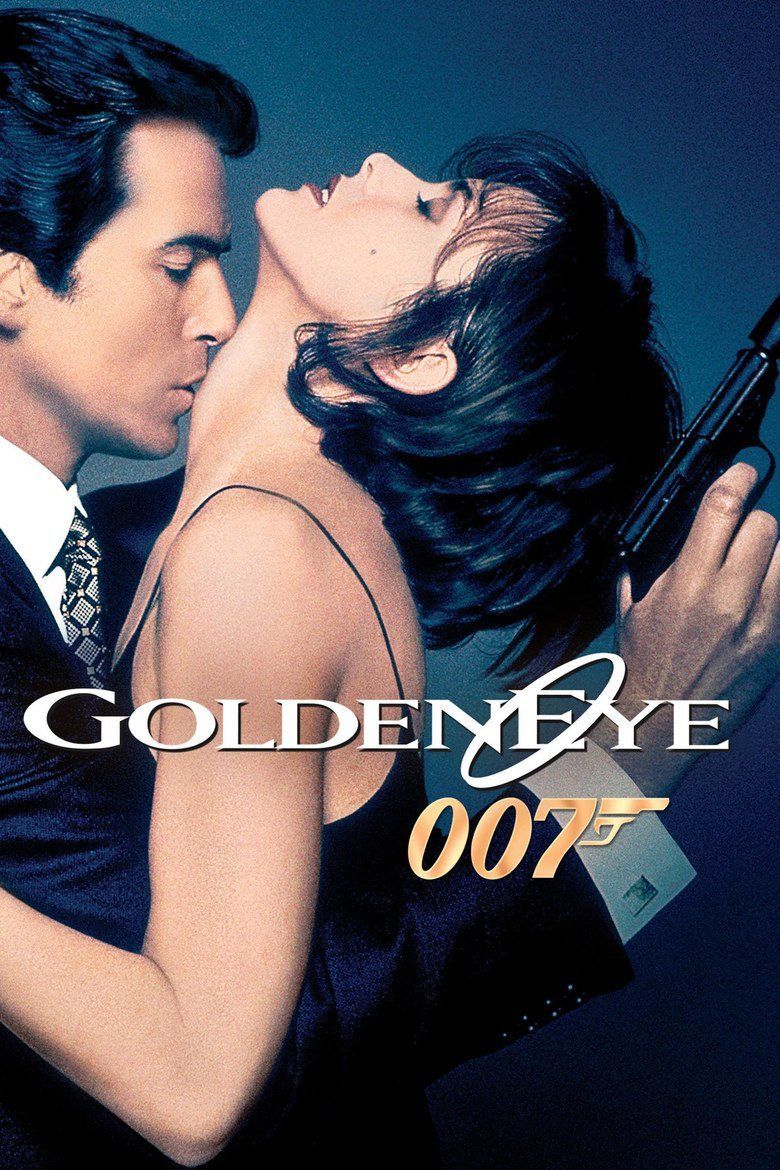 | ||||||||||||||||||||||||||||||||||
Release date 13 November 1995 (1995-11-13) (Los Angeles, premiere)24 November 1995 (1995-11-24) (United Kingdom) Writer Ian Fleming (characters), Michael France (story), Jeffrey Caine (screenplay), Bruce Feirstein (screenplay) Cast (James Bond), (Alec Trevelyan), (Natalya Fyodorovna Simonova), (Xenia Onatopp), (Jack Wade), (M) Similar movies The Living Daylights , The Dark Knight Rises , Mission: Impossible , You Only Live Twice , Dr. No , Watchmen Tagline When the world is the target and the threat is real, you can still depend on one man. | ||||||||||||||||||||||||||||||||||
Goldeneye official trailer 2 pierce brosnan movie 1995 hd
GoldenEye (1995) is the seventeenth spy film in the James Bond series, and the first to star Pierce Brosnan as the fictional MI6 officer James Bond. The film was directed by Martin Campbell and is the first in the series not to take story elements from the works of novelist Ian Fleming. The story was conceived and written by Michael France, with later collaboration by other writers. In the film, Bond fights to prevent an ex-MI6 agent, gone rogue, from using a satellite against London to cause a global financial meltdown.
Contents
- Goldeneye official trailer 2 pierce brosnan movie 1995 hd
- Plot
- Cast
- Prelude
- Pre production and writing
- Filming
- Effects
- Product placement
- Music
- Release and reception
- Reviews
- Awards
- Appearances in other media
- Legacy
- References

GoldenEye was released in 1995 after a six-year hiatus in the series caused by legal disputes, during which Timothy Dalton resigned from the role of James Bond and was replaced by Pierce Brosnan. M was also recast, with actress Judi Dench becoming the first woman to portray the character, replacing Robert Brown. The role of Miss Moneypenny was also recast, with Caroline Bliss being replaced by Samantha Bond; Desmond Llewelyn was the only actor to reprise his role, as Q. GoldenEye was the first Bond film made after the dissolution of the Soviet Union and the end of the Cold War, which provided a background for the plot.
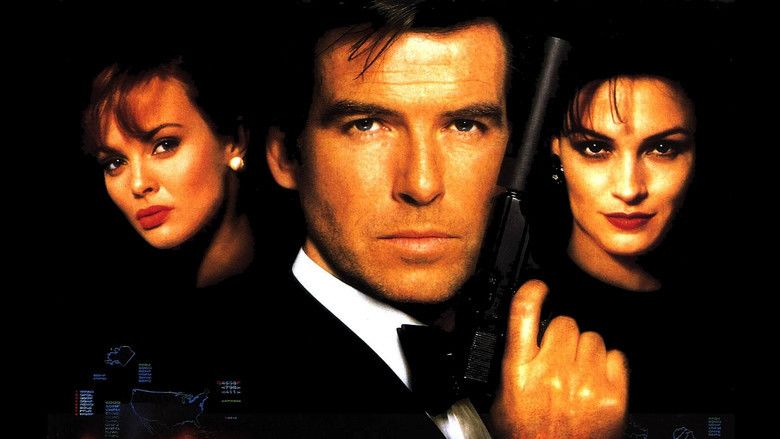
The film accumulated a worldwide gross of US$350.7 million, considerably better than Dalton's films, without taking inflation into account. The film received positive reviews, with critics viewing Brosnan as a definite improvement over his predecessor. The film also received award nominations for "Best Achievement in Special Effects" and "Best Sound" from the British Academy of Film and Television Arts.
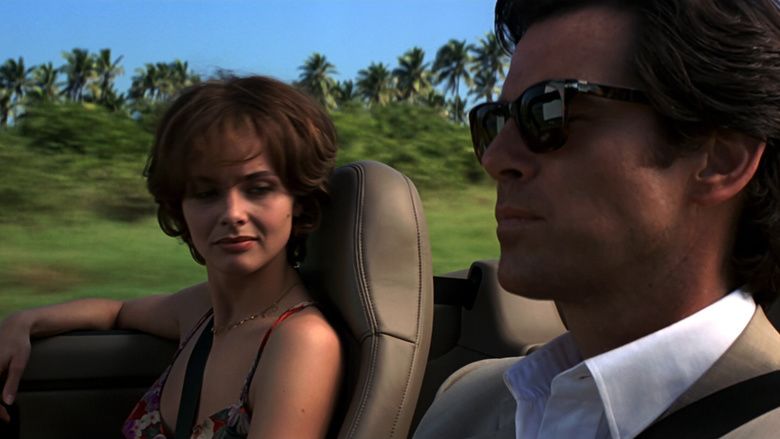
The name "GoldenEye" pays homage to James Bond's creator, Ian Fleming. While working for British Naval Intelligence as a lieutenant commander, Fleming liaised with the American OSS to monitor developments in Spain after the Spanish Civil War in an operation codenamed Operation Goldeneye. Fleming used the name of his operation for his estate in Oracabessa, Jamaica.
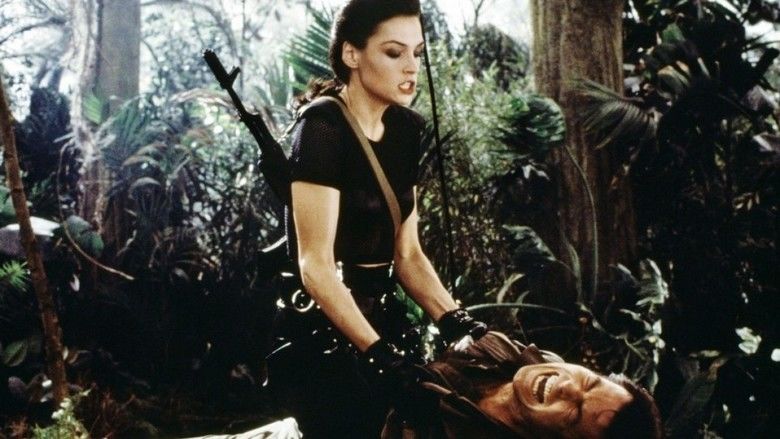
Plot
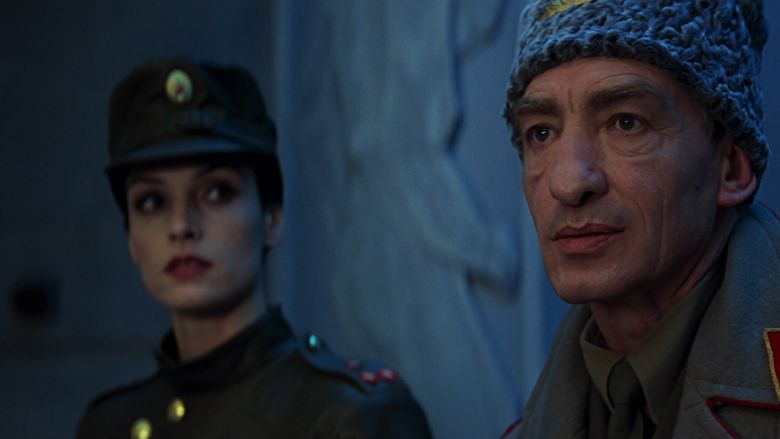
In 1986, at Arkhangelsk, MI6 agents James Bond and Alec Trevelyan infiltrate a Soviet chemical weapons facility and plant explosives. Trevelyan is captured and gunned down by Colonel Arkady Grigorovich Ourumov, but Bond flees as the facility explodes.

Nine years later, in Monte Carlo, Bond follows Xenia Onatopp, a member of the Janus crime syndicate, who has formed a suspicious relationship with Charles Farrel, a Canadian Navy admiral. As Onatopp crushes the admiral to death with her thighs during sex, his credentials are stolen by Ourumov, who uses them to board a French Navy destroyer with Onatopp to steal a Eurocopter Tiger helicopter. Ourumov and Onatopp later fly the helicopter to a bunker in Severnaya, Siberia, where they massacre the staff and steal the control disk for the GoldenEye satellites, two Soviet electromagnetic weapon satellites from the Cold War. They program the first GoldenEye (Petya) to destroy the complex, and escape with programmer Boris Grishenko. Natalya Simonova, the lone survivor, contacts Boris and arranges to meet him in Saint Petersburg, where he betrays her to Janus.
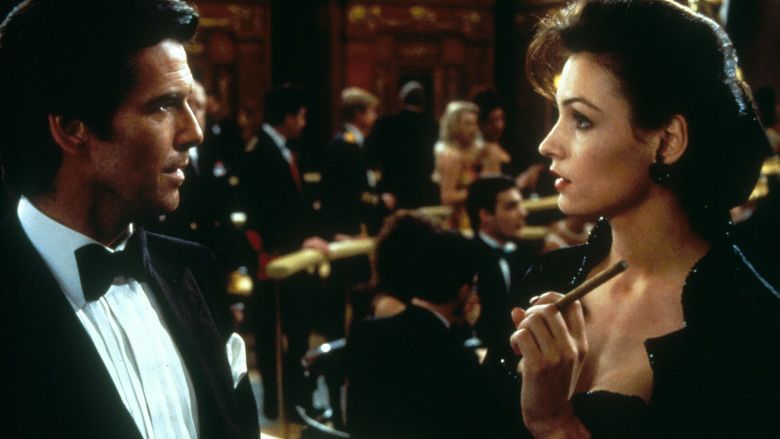
In London, M assigns Bond to investigate the attack. He flies to Saint Petersburg to meet CIA operative Jack Wade, who suggests that Bond meet with Valentin Zukovsky, a former KGB agent and business rival of Janus. Zukovsky arranges a meeting between Bond and Janus. Onatopp surprises Bond at the Grand Hotel Europe and attempts to kill him, but he overpowers her. She takes Bond to Janus, who reveals himself as Trevelyan; he faked his death at Arkhangelsk but was badly scarred by the explosion. A descendant of the Cossack clans who collaborated with the Nazi forces in the Second World War, Trevelyan had vowed revenge against the British after they betrayed the Cossacks, which drove his father to kill Trevelyan's mother and himself. Just as Bond is about to shoot Trevelyan, Bond is shot with a tranquilizer dart.
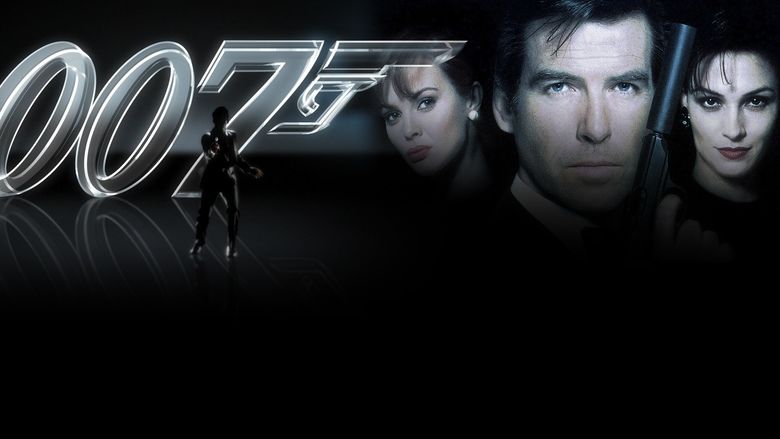
Bond awakens, tied up with Natalya in the helicopter, which has been programmed to self-destruct. They escape but are captured and transported to the Russian military archives, where Minister of Defence Dimitri Mishkin interrogates them. Just as Natalya reveals the existence of a second satellite and Ourumov's involvement in the Siberian massacre, Ourumov arrives and kills Mishkin. Intending to frame Bond for the murder, he calls the guards, but Bond and Natalya escape. In the ensuing firefight, Natalya is captured. Bond steals a tank and pursues Ourumov through St. Petersburg to Trevelyan's train, where he kills Ourumov. Trevelyan escapes and locks Bond in the train with Natalya, setting it to self-destruct. As Bond cuts through the floor with his laser watch, Natalya triangulates Boris' satellite dish to Cuba. The two escape just before the train explodes.
Bond and Natalya meet Wade in Cuba and borrow his plane, where the same night, they make love. The next day, while searching for GoldenEye's satellite dish, they are shot down. Onatopp rappels down from a helicopter and attacks Bond. After a fight ensues, Bond shoots down the helicopter, which snares Onatopp and crushes her to death against a tree. Bond and Natalya watch water draining out of a lake, uncovering the satellite dish. They infiltrate the control station, and Bond is captured. Trevelyan reveals his plan to rob the Bank of England before erasing all of its financial records with the second GoldenEye (Misha), concealing the theft and destroying Britain's economy.
Natalya programs the satellite to initiate atmospheric re-entry and destroy itself. As Trevelyan captures Natalya and orders Grishenko to save the satellite, Boris unwittingly triggers an explosion with Bond's pen grenade (received earlier from Q), which allows Bond to escape to the antenna cradle. Bond sabotages the antenna, preventing Grishenko from regaining control of the satellite. Bond and Trevelyan fight on the antenna's suspended platform, which finishes with Bond holding a dangling Trevelyan by his foot. Bond releases Trevelyan, who plummets into the dish. Seconds later the cradle explodes, and falls, crushing and killing Trevelyan and destroying the base. Amazingly, Boris survives, but is frozen solid in a cascade of liquid nitrogen. Natalya commandeers a helicopter and rescues Bond. It drops them in a field, where the couple are rescued by Wade and a team of Marines.
Cast
Prelude
Following the release of the previous Bond film, Licence to Kill, in July 1989, pre-production work for the third James Bond film starring Timothy Dalton, fulfilling his three-film contract, began in May 1990. A poster for the then-upcoming movie was even featured on the Carlton Hotel during the 1990 Cannes Film Festival. In August, The Sunday Times reported that producer Albert R. Broccoli had parted company with writer Richard Maibaum, who had worked on the scripts of all but three Bond films so far, and director John Glen, responsible for the previous five instalments of the series. Broccoli listed among the possible directors John Landis, Ted Kotcheff, and John Byrum. Broccoli's stepson Michael G. Wilson contributed a script, and Wiseguy co-producer Alfonse Ruggiero Jr. was hired to rewrite. Production was set to start in 1990 in Hong Kong for a release in late 1991.
Dalton would declare in a 2010 interview that the script was ready and "we were talking directors" before the project entered development hell caused by legal problems between Metro-Goldwyn-Mayer, parent company of the series' distributor United Artists, and Broccoli's Danjaq, owners of the Bond film rights. In 1990, MGM/UA was purchased by French-Italian broadcasting group Qintex, owner of the French production company Pathé, and merged with Pathé Communications Group to create MGM-Pathé Communications. Pathé CEO Giancarlo Parretti intended to sell off the distribution rights of the studio's catalogue so he could collect advance payments to finance the buyout. This included international broadcasting rights to the 007 library at cut-rate prices, leading Danjaq to sue, alleging the licensing violated the Bond distribution agreements the company made with United Artists in 1962, while negating Danjaq a share of the profits. The lawsuits were only settled in 1992, while Dalton's original contract with Danjaq expired in 1990.
Pre-production and writing
In May 1993, MGM announced a seventeenth James Bond film was back in the works, to be based on a screenplay by Michael France. With Broccoli's health deteriorating (he died seven months after the release of GoldenEye), his daughter Barbara Broccoli described him as taking "a bit of a back seat" in film's production. Barbara and Michael G. Wilson took the lead roles in production while Albert Broccoli oversaw the production of GoldenEye as a consulting producer, credited as "presenter".
In an interview in 1993, Dalton said that Michael France was writing the screenplay, due to be completed in January or February 1994. Despite France's screenplay being completed by that January, in April 1994 Dalton officially resigned from the role.
After Michael France delivered the original screenplay, Jeffrey Caine was brought in to rewrite it. Caine kept many of France's ideas but added the prologue prior to the credits. Kevin Wade polished the script and Bruce Feirstein added the finishing touches. In the film, the writing credit was shared by Caine and Feirstein, while France was credited with only the story, an arrangement he felt was unfair, particularly as he believed the additions made were not an improvement on his original version. Wade did not receive an official credit, but was acknowledged in the naming of Jack Wade, the CIA character he created.
To replace Dalton, the producers cast Irish actor Pierce Brosnan, who had been prevented from succeeding Roger Moore in 1986 because of his contract to star in the Remington Steele television series. Before negotiating with Brosnan, Mel Gibson, Hugh Grant and Liam Neeson passed on the role. Paul McGann was the studios original choice for the role. He would have been cast as Bond only if Brosnan had turned down the role. Brosnan was paid $1.2 million for the film, out of a total budget of $60 million. Judi Dench, an English actress, was cast as M replacing Robert Brown, making GoldenEye the first film of the series featuring a female M. The decision is widely believed to be inspired by Stella Rimington becoming head of MI5 in 1992. John Woo was approached as the director, and turned down the opportunity, but said he was honoured by the offer. The producers then chose New Zealander Martin Campbell as the director. Brosnan later described Campbell as "warrior-like in his take on the piece" and that "there was a huge passion there on both our parts".
While the story was not based on a work by Ian Fleming, the title GoldenEye traces its origins to the name of Fleming's Jamaican estate where he wrote the Bond novels. Fleming gave a number of origins for the name of his estate, including Carson McCullers' Reflections in a Golden Eye and Operation Goldeneye, a contingency plan Fleming himself developed during World War II in case of a Nazi invasion through Spain.
Although only six years since the release of Licence to Kill, world politics had changed dramatically in the interim. GoldenEye was the first James Bond film to be produced since the fall of the Berlin Wall, the collapse of the Soviet Union, and the end of the Cold War, and therefore it was doubtful whether the character was still relevant in the modern world. Some in the film industry felt it would be "futile" for the Bond series to make a comeback, and that it was best left as "an icon of the past". The producers even thought of new concepts for the series, such as a period piece set in the 1960s, a female 007, or a Black James Bond. Ultimately, they chose to return to the basics of the series, not following the sensitive and caring Bond of the Dalton films or the political correctness that started to permeate the decade. However, when released, the film was considered a successful revitalisation, and it effectively adapted the series for the 1990s. One of GoldenEye's innovations was the casting of a female M. In the film, the new M quickly establishes her authority, remarking that Bond is a "sexist, misogynist dinosaur" and a "relic of the Cold War". This is an early indication that Bond is portrayed as far less tempestuous than Timothy Dalton's Bond from 1989.
Filming
Principal photography for the film began on 16 January 1995 and continued until 2 June. The producers were unable to film at Pinewood Studios, the usual location for Bond films, because it had been reserved for First Knight. Instead, an old Rolls-Royce factory at Leavesden Aerodrome in Hertfordshire was converted into a new studio, dubbed Leavesden Studios. This process is shown on the 2006 DVD's special features.
The bungee jump was filmed at the Contra Dam (also known as the Verzasca or Locarno Dam) in Ticino, Switzerland. The film's casino scenes and the Tiger helicopter's demonstration were shot in Monte Carlo. Reference footage for the tank chase was shot on location in St. Petersburg and matched to the studio at Leavesden. The climactic scenes on the satellite dish were shot at Arecibo Observatory in Puerto Rico. The actual MI6 headquarters were used for external views of M's office. Some of the scenes in St. Petersburg were actually shot in London – the Epsom Downs Racecourse doubled as the airport – to reduce expenses and security concerns, as the second unit sent to Russia required bodyguards.
The French Navy provided full use of the frigate FS La Fayette and their newest helicopter, the Eurocopter Tiger to the film's production team. The French government also allowed the use of Navy logos as part of the promotional campaign for the film. However, the producers had a dispute with the French Ministry of Defence over Brosnan's opposition to French nuclear weapons testing and his involvement with Greenpeace; as a result, the French premiere of the film was cancelled.
The sequences involving the armoured train were filmed on the Nene Valley Railway, near Peterborough in the UK. The train was composed of a British Rail Class 20 diesel-electric locomotive and a pair of BR Mk 1 coaches, all three heavily disguised to resemble a Soviet armoured train.
Effects
GoldenEye was the last film of special effects supervisor Derek Meddings, to whom the film was dedicated. Meddings' major contribution was miniatures. It was also the first Bond film to use computer generated imagery. Among the model effects are most external shots of Severnaya, the scene where Janus' train crashes into the tank, and the lake which hides the satellite dish, since the producers could not find a round lake in Puerto Rico. The climax in the satellite dish used scenes in Arecibo, a model built by Meddings' team and scenes shot with stuntmen in Britain.
Stunt car coordinator Rémy Julienne described the car chase between the Aston Martin DB5 and the Ferrari F355 as between "a perfectly shaped, old and vulnerable vehicle and a racecar." The stunt had to be meticulously planned as the cars are vastly different. Nails had to be attached to the F355 tyres to make it skid, and during one take of the sliding vehicles, the two cars collided. The largest stunt sequence in the film was the tank chase, which took around six weeks to film, partly on location in St. Petersburg and partly at Leavesden. A Russian T-54/55 tank, on loan from the East England Military Museum, was modified with the addition of fake explosive reactive armour panels. To avoid destroying the pavement on the city streets of St. Petersburg, the steel off-road tracks of the T-54/55 were replaced with the rubber-shoed tracks from a British Chieftain tank. The T-55 Tank used in the film is now on permanent display at Old Buckenham Airport where the East England Military Museum is based.
For the confrontation between Bond and Trevelyan inside the antenna cradle, director Campbell decided to take inspiration from Bond's fight with Red Grant in From Russia with Love. Pierce Brosnan and Sean Bean did all the stunts themselves, except for one take where one is thrown against the wall. Brosnan injured his hand while filming the extending ladder sequence, making producers delay his scenes and film the ones in Severnaya earlier.
The opening 220 m (720 ft) bungee jump at Arkhangelsk, shot at the Contra Dam in Switzerland and performed by Wayne Michaels, was voted the best movie stunt of all time in a 2002 Sky Movies poll, and set a record for the highest bungee jump off a fixed structure. The ending of the pre-credits sequence with Bond jumping after the aeroplane features Jacques Malnuit riding the motorcycle to the edge and jumping, and B.J. Worth diving after the plane – which was a working aircraft, with Worth adding that part of the difficulty of the stunt was the kerosene striking his face.
The fall of Communism in Russia is the main focus of the opening titles, designed by Daniel Kleinman (who took over from Maurice Binder after his death in 1991). They show the collapse and destruction of several structures associated with the Soviet Union, such as the red star, statues of Communist leaders—notably Joseph Stalin—and the hammer and sickle. In an interview, Kleinman said they were meant to be "a kind of story telling sequence" showing that "what was happening in Communist countries was Communism was falling down". According to producer Michael G. Wilson, some Communist parties protested against "Socialist symbols being destroyed not by governments, but by bikini-clad women", especially certain Indian Communist parties, which threatened to boycott the film.
Product placement
GoldenEye was the first film bound by BMW's three-picture deal, so the producers were offered BMW's latest roadster, the BMW Z3. It was featured in the film months before its release, and a limited edition "007 model" sold out within a day of being available to order. As part of the car's marketing strategy, several Z3's were used to drive journalists from a complimentary meal at the Rainbow Room restaurant to GoldenEye's premiere at Radio City Music Hall.
For the film, a convertible Z3 is equipped with the usual Q refinements, including a self-destruct feature and Stinger missiles behind the headlights. The Z3 does not have much screen time and none of the gadgets are used, which Martin Campbell attributed to the deal with BMW coming in the last stages of production. The Z3's appearance in GoldenEye is thought to be the most successful promotion through product placement in 1995. Ten years later, The Hollywood Reporter listed it as one of the most successful product placements in recent years. The article quoted Mary Lou Galician, head of media analysis and criticism at Arizona State University's Walter Cronkite School of Journalism and Mass Communication, as saying that the news coverage of Bond's switch from Aston Martin to BMW "generated hundreds of millions of dollars of media exposure for the movie and all of its marketing partners."
In addition, all computers in the film were provided by IBM, and in some scenes (such as the pen grenade scene towards the end), the OS/2 Warp splash screen can be seen on computer monitors.
A modified Omega Seamaster Quartz Professional watch features as a major plot device several times in the film. It is shown to contain a remote detonator and a laser. This was the first time James Bond was shown to be wearing a watch by Omega, and the character has since worn Omega watches in every subsequent production.
Music
The theme song, "GoldenEye", was written by Bono and the Edge, and was performed by Tina Turner. As the producers did not collaborate with Bono or the Edge, the film score did not incorporate any of the theme song's melodies, as was the case in previous James Bond films. Swedish group Ace of Base had also written a proposed theme song, but label Arista Records pulled the band out of the project fearing the negative impact in case the film flopped. The song was then re-written as their single "The Juvenile".
The soundtrack to GoldenEye was composed and performed by Éric Serra. Prolific Bond composer John Barry said that despite an offer by Barbara Broccoli, he turned it down. Serra's score has been criticised: Richard von Busack, in Metro, wrote that it was "more appropriate for a ride on an elevator than a ride on a roller coaster", and Filmtracks said Serra "failed completely in his attempt to tie Goldeneye to the franchise's past." The end credits song, Serra's "The Experience of Love", was based on a short cue Serra had originally written for Luc Besson's Léon one year earlier.
Later John Altman provided the music for the tank chase in St. Petersburg. Serra's original track for that sequence can still be found on the soundtrack as "A Pleasant Drive in St. Petersburg". Serra composed and performed a number of synthesiser tracks, including the version of the "James Bond Theme" that plays during the gun barrel sequence, while Altman and David Arch provided the more traditional symphonic music.
Release and reception
GoldenEye premiered on 13 November 1995, at the Radio City Music Hall in New York City, and went on general release in the USA on 17 November 1995. The UK premiere, attended by Prince Charles, followed on 22 November at the Odeon Leicester Square, with general release two days later. Brosnan boycotted the French premiere to support Greenpeace's protest against the French nuclear testing program.
The film earned over $26 million during its opening across 2,667 cinemas in the USA. Its worldwide sales were around the equivalent of $350 million. It had the fourth-highest worldwide gross of all films in 1995 and was the most successful Bond film since Moonraker, taking inflation into account.
GoldenEye was edited to be guaranteed a PG-13 rating from the MPAA and a 12 rating from the BBFC. The cuts included the visible bullet impact to Trevelyan's head when he is shot in the prologue, several additional deaths during the sequence in which Onatopp guns down the workers at the Severnaya station, more explicit footage and violent behaviour in the Admiral's death, extra footage of Onatopp's death, and Bond giving her a rabbit punch in the car. In 2006, the film was re-mastered and re-edited for the James Bond Ultimate Edition DVD in which the BBFC cuts were restored, causing the rating to be changed to 15. However, the original MPAA edits still remain.
Reviews
The critical reception of the film was mostly positive. Film review collection website Rotten Tomatoes holds it at a 78% approval rating, while a similar site, Metacritic, holds it at 65%. In the Chicago Sun-Times, Roger Ebert gave the film 3 stars out of 4, and said Brosnan's Bond was "somehow more sensitive, more vulnerable, more psychologically complete" than the previous ones, also commenting on Bond's "loss of innocence" since previous films. James Berardinelli described Brosnan as "a decided improvement over his immediate predecessor" with a "flair for wit to go along with his natural charm", but added that "fully one-quarter of Goldeneye is momentum-killing padding."
Several reviewers lauded M's appraisal of Bond as a "sexist, misogynist dinosaur", with Todd McCarthy in Variety saying GoldenEye "breathes fresh creative and commercial life" into the series. John Puccio of DVD Town said that GoldenEye was "an eye and ear-pleasing, action-packed entry in the Bond series" and that the film gave Bond "a bit of humanity, too". Ian Nathan of Empire said that GoldenEye "revamps that indomitable British spirit" and that the Die Hard movies "don't even come close to 007". Tom Sonne of the Sunday Times considered GoldenEye the best Bond film since The Spy Who Loved Me. Jose Arroyo of Sight & Sound considered the greatest success of the film was in modernising the series.
GoldenEye was also ranked high in Bond-related lists. IGN chose it as the fifth-best movie, while Entertainment Weekly ranked it eighth, and Norman Wilner of MSN as ninth. ET also voted Xenia Onatopp as the sixth-most memorable Bond Girl, while IGN ranked Natalya as seventh in a similar list.
However, the film received several negative reviews. Richard Schickel of Time wrote that after "a third of a century's hard use", Bond's conventions survived on "wobbly knees", while in Entertainment Weekly, Owen Gleiberman thought the series had "entered a near-terminal state of exhaustion." Dragan Antulov said that GoldenEye had a predictable series of scenes, and Kenneth Turan of the Los Angeles Times said that the film was "a middle-aged entity anxious to appear trendy at all costs". David Eimer of Premiere wrote that "the trademark humour is in short supply" and that "Goldeneye isn't classic Bond by any stretch of the imagination." Madeleine Williams said that "there are plenty of stunts and explosions to take your mind off the plot."
Awards
GoldenEye was nominated for two BAFTAs, Best Sound and Special Effects, but lost to Braveheart and Apollo 13, respectively. Éric Serra won a BMI Film Award for the soundtrack and the film also earned nominations for Best Action Film and Actor at the Saturn Awards and Best Fight Scene at the MTV Movie Awards.
Appearances in other media
GoldenEye was the second and final Bond film to be adapted to a novel by novelist John Gardner. The book closely follows the film's storyline, but Gardner added a violent sequence prior to the opening bungee jump in which Bond kills a group of Russian guards, a change that the video game GoldenEye 007 retained.
In late 1995, Topps Comics began publishing a three-issue comic book adaptation of GoldenEye. The script was adapted by Don McGregor with art by Rick Magyar. The first issue carried a January 1996 cover date. For unknown reasons, Topps cancelled the entire adaptation after the first issue had been published, and to date the adaptation has not been released in its entirety.
The film was the basis for GoldenEye 007, a video game for the Nintendo 64 developed by Rare (known at the time as Rareware) and published by Nintendo. The game was praised by critics and in January 2000, readers of the British video game magazine Computer and Video Games listed GoldenEye 007 in first place in a list of "the hundred greatest video games". In Edge's 10th anniversary issue in 2003, the game was included as one of their top ten shooters of all time. It is based upon the film, but many of the missions were extended or modified.
GoldenEye 007 was modified into a racing game intended to be released for the Virtual Boy console. However, the game was cancelled before release. In 2004, Electronic Arts released GoldenEye: Rogue Agent, the first game of the James Bond series in which the player does not take on the role of Bond. Instead, the protagonist is an aspiring Double-0 agent Jonathan Hunter, known by his codename "GoldenEye" recruited by a villain of the Bond universe, Auric Goldfinger. Except for the appearance of Xenia Onatopp, the game was unrelated to the film, and was released to mediocre reviews. It was excoriated by several critics including Eric Qualls for using the name "GoldenEye" as an attempt to ride on the success of Rare's game. In 2010, an independent development team released GoldenEye: Source, a multiplayer only total conversion mod developed using Valve's Source engine.
Nintendo announced a remake of the original GoldenEye 007 game at their E3 press conference on 15 June 2010. The game is a modernised retelling of the original movie's story, with Daniel Craig playing the role of Bond. Bruce Feirstein returned to write a modernised version of the script, while Nicole Scherzinger covered Tina Turner's theme song. The game was developed by Eurocom and published by Activision for the Wii and Nintendo DS and was released in November 2010. Both Wii and DS versions bear little to no resemblance to the locations and weapons of the original N64 release. In 2011 the game was ported to PlayStation 3 and Xbox 360 under the name GoldenEye 007: Reloaded.
Legacy
The malware Petya (also known as "Goldeneye") is a reference to the film. A Twitter account, suspected by the German newspaper Heise Online to belong to the malware author, used an image of Boris Grishenko as his/her avatar.
References
GoldenEye WikipediaGoldenEye IMDbGoldenEye Rotten TomatoesGoldenEye MetacriticGoldenEye themoviedb.org
